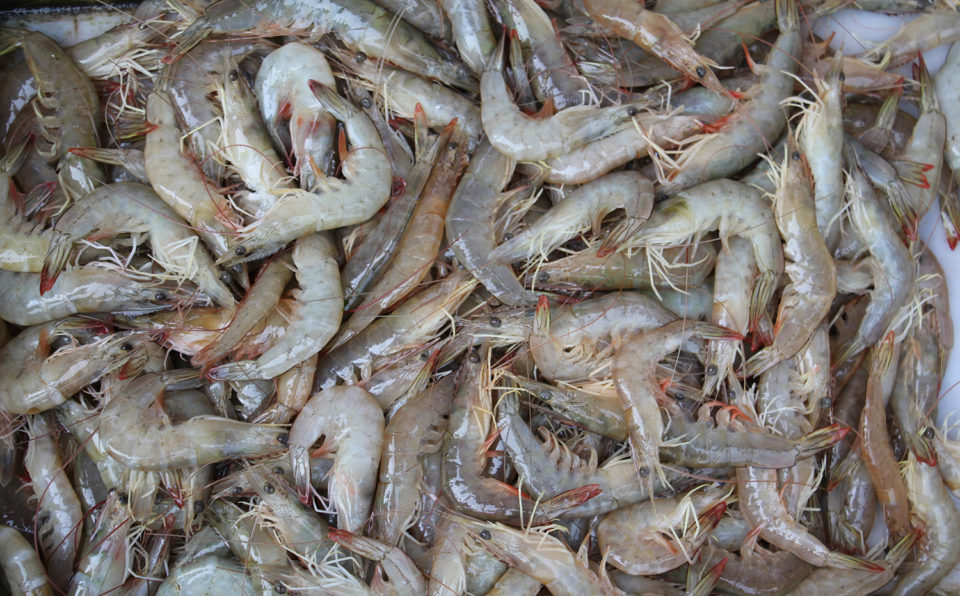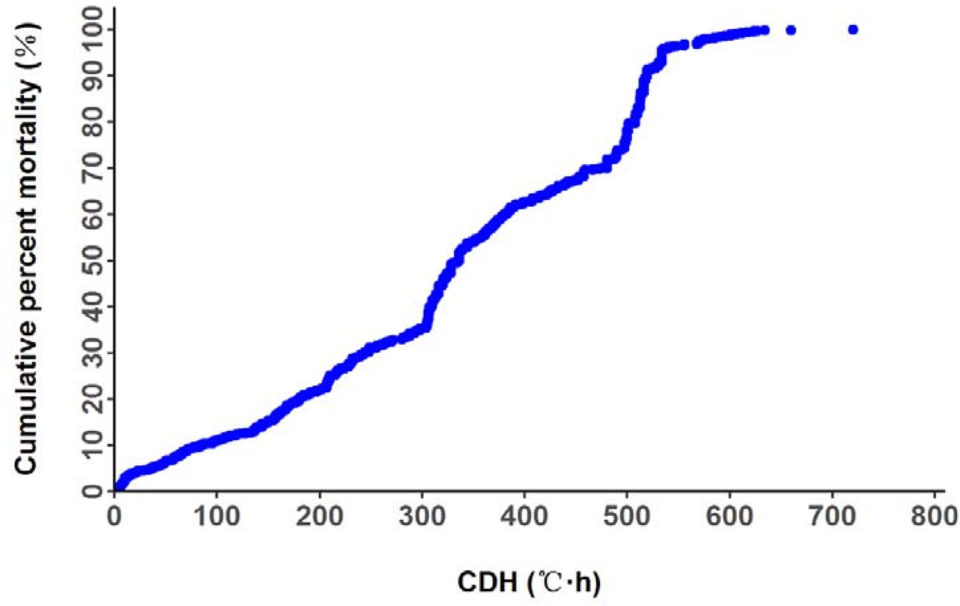Results showed low heritability, low correlation between these traits

Editor note: This article has nine co-authors (listed in the tags below), but we only include affiliation information for the corresponding author, Dr. Xianhong Meng. For more information, refer to original publication.
The Chinese white shrimp (Fenneropenaeus chinensis) – also known as oriental or fleshy prawn – is commercially cultivated in China. The species is one of the most representative indigenous aquaculture species in the country, it is mainly distributed in the Yellow Sea and Bohai Sea area, and cultured in Shandong, Hebei, Liaoning, Tianjin, Jiangsu offshore, as well as the west and south coasts of the Korean Peninsula. Its optimum water temperatures range from 18 to 30 degrees-C – although it tolerates 4 to 38 degrees-C – with an optimum temperature of around 25 degrees-C.
Hatchery production of seedstock started developing in the 1970s, and the culture area expanded through the 1980s. From 1988 to 1993, annual farmed production of F. chinensis yielded as much as over 200,000 metric tons (MT), with very significant economic benefits to the aquaculture industry. However, in 1993 the F. chinensis farming industry has hit by the white spot syndrome virus (WSSV) and suffered serious economic losses, with 1994 national production falling sharply to around 60,000 MT. This led to significant research efforts that resulted in the development of three new lines or varieties of Chinese white shrimp, namely the Huanghai No. 1 in 2003, the Huanghai No. 2 in 2008, and the Huanghai No. 3 in 2013, which enabled a gradual recovery of China’s farming of F. chinensis.
However, in recent years, the shrimp farming industry is facing new problems. The intensifying, abnormal climate – especially repeated cold spells nationwide – has resulted in significant shrimp mortality and serious economic losses to shrimp farmers. It is expected that the production of more cold-tolerant shrimp species like F. chinensis will help alleviate this issue.
This article – adapted and summarized from the original publication – presents results of an evaluation of the growth and cold tolerance traits of F. chinensis juveniles from 99 different families. The study used an indoor artificial cold tolerance challenge with analysis of heritability of body weight (BW), body length (BL) and other parameters. This evaluation would provide a theoretical basis for breeding more cold tolerance varieties of F. chinensis.
Study setup
The experiment was conducted at the Mariculture Research Station of the Yellow Sea Fisheries Research Institute, Chinese Academy of Fishery Sciences in Qingdao City, Shandong Province, China. The experimental materials were 99 Huanghai No. 2 families of F. chinensis developed in 2015 (including 12 half-sib families), representing the G10-generation, at age of 40 days.
For the cold tolerance challenge treatment, 30 juvenile shrimp (average body weight of 0.073 ± 0.043 grams and body length of 19.790 ± 3.607 mm, respectively) were randomly sampled from each family and placed in water in aerated storage boxes (26.5 x 20 x 16.5 cm). The boxes were placed in a refrigerator adjustable temperature. The refrigerator temperature was initially dropped to 14 degrees-C at a rate of 2 degrees-C daily, and then further dropped to (and maintained at) 4 degrees-C at a rate of 2 degrees-C daily, until all the juvenile shrimps died. The juvenile shrimp were fed four times daily and 30 percent of the water exchanged every day. Dead shrimps were collected every two hours and information data collected on family, temperature at mortality, and body weight and body length.
For detailed information on the experimental design and setup; the cold tolerance challenge treatment of the juveniles, data processing; estimates of heritability and correlation analysis of growth traits; and correlation analysis of growth traits and cold tolerance traits in F. chinensis juveniles, please consult the original publication.
Results and discussion
The sample size, mean, maximum, minimum, standard deviation and coefficient variation for growth and cold tolerance traits of F. chinensis are shown in Table 1. The mean body weight (BW), body length (BL), temperature at death (TAD), cooling degree hours (CDH) and survival rate for each family at half lethal time (SR50) were 0.073 grams, 19.790 mm, 6.506 degrees-C, 333.937 degrees-C*h, and 48.950 percent, respectively, with coefficients of variation ranging from 18.226 percent to 59.919 percent.
Wang, cold tolerance, Table 1
| Traits | Number | Mean | Minimum | Maximum | Coefficient of variation (%) |
|---|---|---|---|---|---|
| Body weight (g) | 2,508 | 0.073 | 0.005 | 0.370 | 59.919 |
| Body length (mm) | 2,508 | 19.79 | 9.610 | 33.120 | 18.226 |
| Cooling degree hours (degrees-C*hour) | 2,508 | 333.937 | 0.800 | 720.000 | 48.221 |
| Temperature at death (degrees-C) | 2,508 | 6.506 | 3.000 | 14.000 | 36.241 |
| Half lethal time, SR50 (%) | 99 | 48.95 | 0.000 | 100.000 | 54.107 |
The coefficient of variation of body weight was the greatest (59.919 percent), indicating that there was great variance in body weight between the different families. while the coefficient of variation of body length was the smallest (18.226 percent), indicating that there was comparatively small variance in body length between different families. Among all the cold tolerance traits, the SR50had the highest phenotypic variance, with 54.107 percent coefficient variation. It was followed by CDH (48.221 percent), and by TAD with the lowest (36.241 percent).
In the cold tolerance challenge experiment, mortality of shrimp was observed when water temperature was 13.9 degrees-C and the CDH was 0.800 degrees-C*h. All the shrimps had died by the time the CDH reached 720 degrees-C*h (Fig 1). The cumulative mortality curve is shown in Fig 1.

Regarding the heritability for growth traits of F. chinensis juveniles, our research results showed that the heritabilities for body weight and body length were low (0.078 ± 0.124 and 0.131 ± 0.133, respectively). The heritabilities for growth traits obtained in various studies by other researchers were higher than those obtained in our study because the heritability estimates were affected by different shrimp varieties or different growth periods (age) of the same variety, and by the different genetic backgrounds and structures of the breeding populations.
TAD and CDH were the parameters used to estimate heritability for cold tolerance in our study. The heritability estimates for TAD and CDH were 0.265 ± 0.091 and 0.077 ± 0.058, respectively, which were moderate and low in magnitude. The heritability for cold tolerance traits of F. chinensis juveniles have not been previously reported, but Li Wenjia and co-workers have previously evaluated the heritability of cold tolerance traits like CDH in Pacific white shrimp (Litopenaeus vannamei) adults and reported it as low with an estimate of 0.0258 ± 0.0205.
Regarding the correlation analysis of growth and cold tolerance traits of F. chinensis juveniles, our results showed that the phenotypic correlations between growth and cold tolerance were low. The genetic correlation has a larger range (0.0526 ~ 0.9914), and all were not significantly different from zero due to large standard errors. The results essentially agreed with the results of other researchers, who studied genetic correlation between growth and cold tolerance traits of L. vannamei and genetic correlation between body weight and cold tolerance traits of Nile tilapia, respectively.
Perspectives
Results from this study showed that there was a low correlation between growth and cold tolerance traits, indicating that growth and cold tolerance should be considered collectively in the breeding program of shrimp.
Further studies are required for the correlation of different traits of F. chinensis, so as to provide more accurate data for breeding of cold tolerance F. chinensis. In addition, based on traditional breeding methods, traits of low heritability could be improved by means of studies of molecular biology to accelerate the breeding process.
Now that you've finished reading the article ...
… we hope you’ll consider supporting our mission to document the evolution of the global aquaculture industry and share our vast network of contributors’ expansive knowledge every week.
By becoming a Global Seafood Alliance member, you’re ensuring that all of the pre-competitive work we do through member benefits, resources and events can continue. Individual membership costs just $50 a year. GSA individual and corporate members receive complimentary access to a series of GOAL virtual events beginning in April. Join now.
Not a GSA member? Join us.
Author
-
Dr. Xianhong Meng
Corresponding author
Key Laboratory of Sustainable Utilization of Marine Fisheries Resources, Ministry of Agriculture, Yellow Sea Fisheries Research Institute, Chinese Academy of Fishery Sciences, Qingdao, China; and Laboratory for Marine Fisheries Science and Food Production Processes, Qingdao National Laboratory for Marine Science and Technology, Qingdao, China; and Shanghai Ocean University, Shanghai, China
[110,99,46,99,97,46,105,114,102,115,121,64,103,110,111,104,110,97,105,120,103,110,101,109]
Tagged With
Related Posts

Health & Welfare
CENIACUA develops WSSV-resistant shrimp in Colombia
To combat white spot syndrome virus (WSSV) in white shrimp, Corporación Centro de Investigación de la Acuacultura de Colombia (CENIACUA) initiated a selective-breeding program to develop resistance in shrimp.

Health & Welfare
Genetic improvement programs for shrimp vary between Asia, Americas
There is a clear difference between the shrimp postlarvae traits that are economically important in Central and South America versus those of Asia, creating a challenge for breeders to satisfy the somewhat opposing breeding goals the regions demand.

Health & Welfare
Genetic variation for resistance to WSS, AHPND in Pacific white shrimp
Selection for disease resistance has been used in breeding farm animals and can be a viable option to deal with white spot syndrome and acute hepatopancreatic necrosis disease in commercial shrimp culture. In trials, heritability for AHPND resistance was low, while that for WSS was moderate.

Health & Welfare
Selective breeding advances hybrid abalone
Collaborative work at Great Southern Waters has established a closed, genetically diverse breeding population of hybrid abalone. The breeding strategy is to produce and improve commercial stocks with the required hybrid traits by understanding the inheritance of those traits in the pure species and the hybrids.


